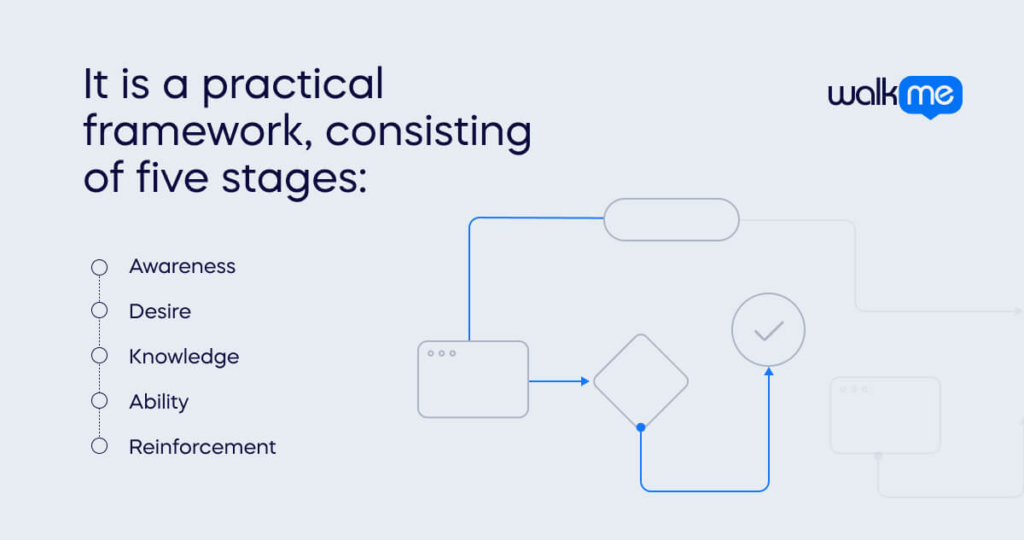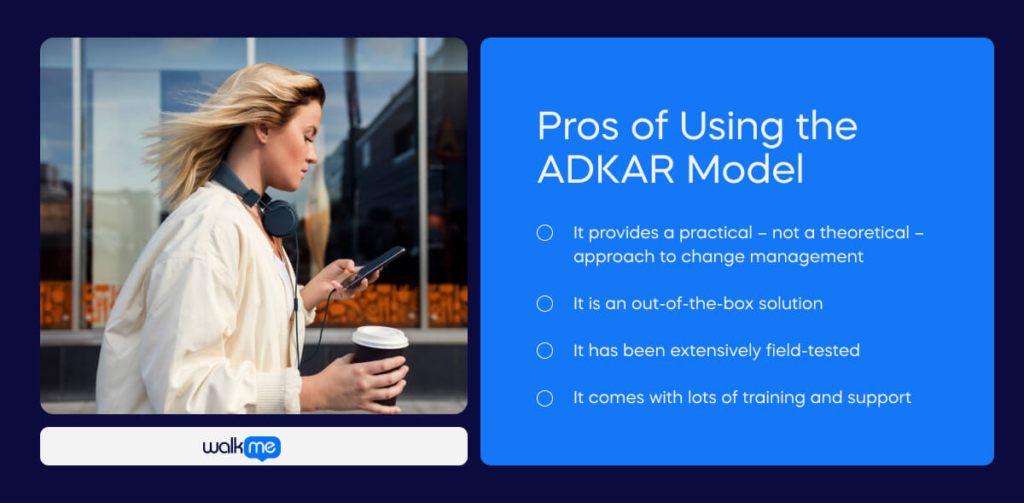What is the ADKAR model in change management? And is it right for your business?
Below, we’ll explore the ADKAR model in detail, including:
- How it works
- What its benefits are
- Its drawbacks
- How to decide if the ADKAR model is right for your business
Let’s start with a quick overview of this framework.
A Quick Tour of the ADKAR Model
The ADKAR change management framework is a step-by-step approach to organizational change management.
This model was created by Jeff Hiatt, the founder of the change management consultancy, Prosci.
This model is based on the change at the individual level – change from the ground up.
It is a practical framework, consisting of five stages:

- Awareness – The first step to any change is generating awareness for change. Individuals must understand what the change is, why it’s being made, and the risk of not changing.
- Desire – Next, change practitioners must kindle a desire for change in employees. That is, they should influence individuals. But ultimately, the individual must choose to willingly support that change.
- Knowledge – Unless workers have the skills, knowledge, tools, and processes to change, they will not make progress. Effective change management means acquiring the knowledge to change and the knowledge to perform after the change.
- Ability – Ability translates knowledge into action. In this stage, employees must turn their learning into practical application, via training, coaching, and support.
Reinforcement – Finally, change must be sustained. Reinforcement is critical, and can include recognition and rewards, as well as internal satisfaction.
Effective change management is difficult, which is why the ADKAR framework is so valuable.
Pros of Using the ADKAR Model

There are plenty of benefits to using the ADKAR model:
- It provides a practical – not a theoretical – approach to change management. Some change frameworks merely describe group psychology or organizational change. These theoretical approaches can be useful, but they are difficult to apply directly.
- It is an out-of-the-box solution. Businesses shouldn’t have to reinvent the wheel. This makes ADKAR an excellent choice for companies that want ready-made recipes for change.
- It has been extensively field-tested. ADKAR has been around for a while. Also, it is one of the most popular and widely used change models, a testament to its success.
- It comes with lots of training and support. Prosci, the company behind ADKAR, offers extensive training and support at reasonable prices. Businesses, therefore, always have coaches and trainers to help them as they change and grow.
For these reasons, ADKAR is an excellent choice for many businesses.
But is it right for your company?
When Not to Use the ADKAR Model
It’s difficult to find fault with the ADKAR model, given the benefits mentioned above.
However, there are situations when a business may want to consider other change management frameworks.
As mentioned, ADKAR is focused on change at the individual level.
And because it offers a very prescriptive approach to change management, it may not be useful for every business.
For example, a company may want to explore other options when they…
- Want deeper knowledge around change management. As mentioned ADKAR comes ready-made. This can be beneficial if you want something you can apply quickly. But it can be a drawback if your business wants to gain a deeper understanding of the field.
- Need to develop more sophisticated, complex change management processes. There is nothing wrong with ADKAR, per se, but it may not be useful for every enterprise. When a company wants or needs to design a different process for change, they will likely need to explore other options.
- Are innovating or creating an in-house change management function? Prosci is certainly capable of assisting with the development of in-house change management capabilities. However, innovative companies may wish to hire their own change management expertise and develop custom in-house processes.
- Are making certain types of business changes. A company undergoing digital transformation, for instance, may be adopting multiple technologies simultaneously. In such cases, companies may need to draw on expertise from digital transformation agencies, digital adoption solutions, IT consultancies, and so on.
Have a different value system or culture. Finally, some businesses may simply be a cultural mismatch with the Prosci system. In that case, it would only make sense to look at different change models.
These are just a few reasons to consider options besides the ADKAR framework.
Final Thoughts
Should you use the ADKAR model?
Prosci’s solutions are quite affordable – and they offer a number of change management solutions.
They also provide:
- Workshops
- Certificate courses
- Coaching and consulting
- Onsite or online training
Among other things.
When deciding whether ADKAR is right for you, consider the nature of the proposed change, your needs, and Prosci’s solutions.
If you need a “total package” that provides streamlined training, consulting, and support, then ADKAR is worth a look.
However, this 5-step business model does not always fit every business situation.
Before making your decision, be sure to review the considerations mentioned above, as well as other change management resources on this blog.
Common Questions
By addressing individual transitions, the ADKAR model helps employees understand, accept, and effectively use AI technologies, ensuring smoother integration and minimizing resistance
Each stage of the ADKAR model builds upon the previous one; skipping stages can lead to misunderstandings, lack of commitment, and failure to sustain change.
Organizations should reassess their strategy when facing persistent resistance, low adoption rates, or after significant organizational changes to ensure alignment with current objectives.
This indicates a lack of reinforcement; organizations should implement ongoing support, recognition, and feedback mechanisms to sustain new behaviors and prevent regression.

